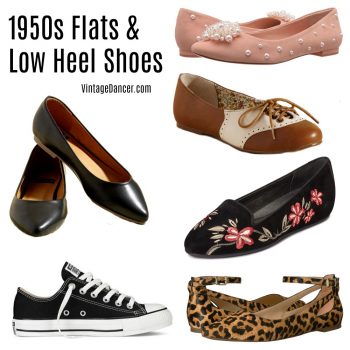Question: I can’t wear heels. What flats can I wear with my [insert decade] dress and still be authentic?
The answer to this common question is a tricky one. For the most part, up until the late 1950s, flats were not an option. There were some low heel shoes that were advertised for “at home wear” as well as sporty casual shoes that had low or no heels, but for day to day wear, a woman had to wear heels. Even her house slippers had heels! Men’s shoes also had small heels on everything from Oxfords to boots and, yes, house slippers.
So what are you to wear when vintage heeled shoes are not an option? Let’s explore the flat or low heel shoes that were available in the ’20s, ’30s, ’40s, and ’50s, and then look for some modern equivalents.
1920s Vintage Flats
Most women’s shoes in the 1920s had 2-3 inch heels. Lower heel Oxfords, Mary Janes, and a few T-straps were worn around the house or while running local errands. Oxfords, which were styled after men’s shoes, had 1/4 to 1/2 inch heels. They were considered sporty shoes, meaning they were worn with casual clothing while playing a sport — typically paired with pleated skirts, knickers, and pants (gasp!). Low heel “sport” Oxfords were usually not worn with dresses, although I am sure many women did anyway. In the early years, the toes were round and a little pointy. By the middle to end of the decade, the toes flattened out to a square shape, making more room for toes to move and breathe.
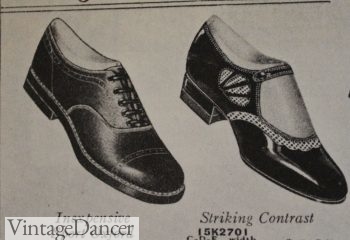
Low heel oxford and fancy Mary Jane shoes
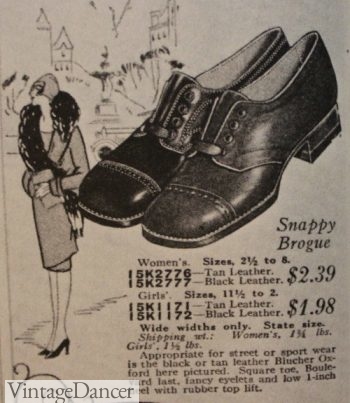
1 inch heel oxford “brogue” shoes with square toe
In summer, many low heel Mary Jane shoes were made of canvas. These were worn to the beach or other leisure activities as well as for certain occupations (like nurses). Leather versions also existed for cooler months. These are the lowest heel shoes I could find. The heel is a small 1/2 to 3/4 inch. Most were single strap shoes, although a T-strap was popular as a summer sandal.
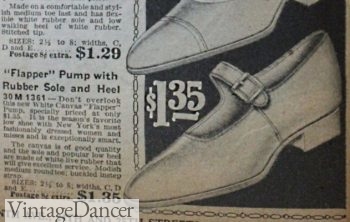
Canvas “Flapper Shoes” for summer
Another casual shoe was the sporty gym shoe. They were usually only worn by children or women playing sports. Made of canvas uppers with an almost flat rubber sole, they are the only truly “flat” shoes of the ’20s. They are the 1920s version of “Keds” or “Plimsoll” style shoes, a style that has never gone out of fashion.
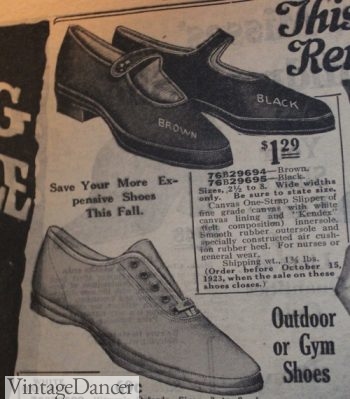
Basic canvas single strap shoes and classic white canvas sport shoes
Flat dressy shoes were not available in the ’20s. The only example I could find was an early ’20s slipper pump with a flat bow on the toe. Fancy T-traps and Mary Janes may have been offered as a low heel option, too, although they were not often illustrated in magazines and catalogs.
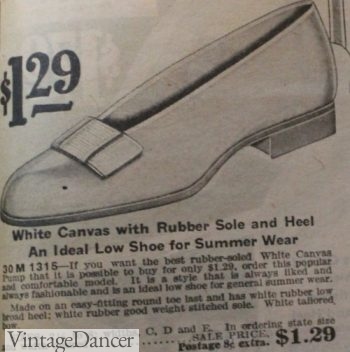
Canvas pumps with low heels
For your ’20s look, a low heel Oxford or Mary Jane shoe is your safest bet. Although low heel T-straps did not come about until the ’30s, you can wear them as well for a dressier look. Here are some good options:
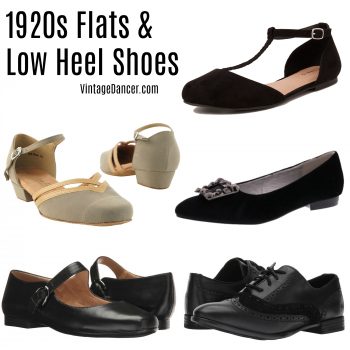
1920s Flats – T straps, Mary Janes, pumps, and Oxfords
1930s Flats
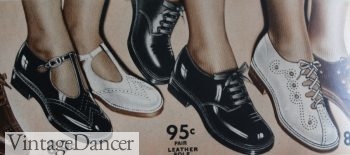
Low Heel 1930s shoes- T Strap, Oxford, Ghillie
Oxfords and simple Mary Jane shoes continued to be worn in the 1930s. Low heels remained common leisure time or work shoes. Oxfords in the ’30s featured broguing (small holes) in most spring and summer styles. Some had alternative lacings such as the Ghillie style (see above right) or color combinations that mimicked men’s two-tone wingtip shoes. Casual Oxfords were worn with high waisted pants, overalls, and rompers for an easygoing summer fashion. The menswear Oxfords could also be worn with more sophisticated trousers, vests, and jackets for a masculine-meets-feminine look. The heel height was 1/2 inch at the lowest.
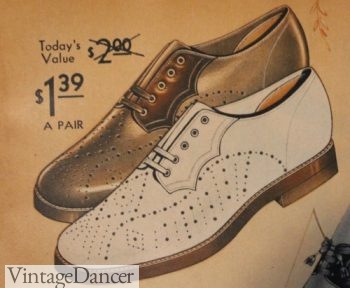
1930s summer oxfords
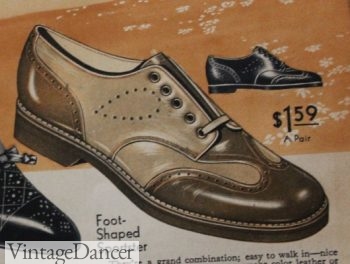
1930s menswear-inspired oxfords
The simple canvas shoes that were popular in the 1920s remained a popular summer sandal in the 1930s. So did the flat gym sneaker with rubber crepe sole. They came in all sorts of colors and two-tone combinations. Even the classic saddle Oxford appeared in new materials (like canvas or suede) and more colors (see below). The heel remained quite low with barely a 1/4 inch rise above the sole. These sporty styles were worn with casual summer skirts, pants, and some dresses. It was a frugal time, so sporty footwear was worn for all occasions and all styles of casual dress.
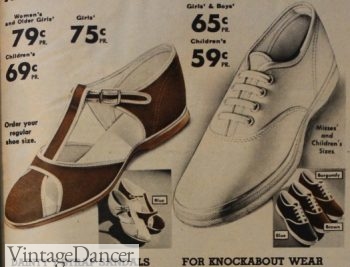
1930s sneakers and canvas sandals
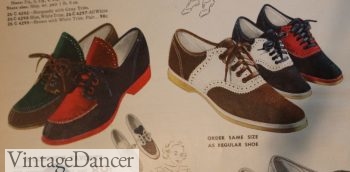
1930s colored saddle shoes and lace-up mocs
For fancier occasions, the T strap shoes replaced the single strap, Mary Jane. Most evening shoes had at least a 1-inch heel but daytime shoes could be less. Again, in summer, the casual low heel shoe morphed into the strappy sandal which in turn morphed into a strappy evening sandal. The two looks were nearly interchangeable with matte leather and fabrics for daywear and shiny patent leather for the evening.
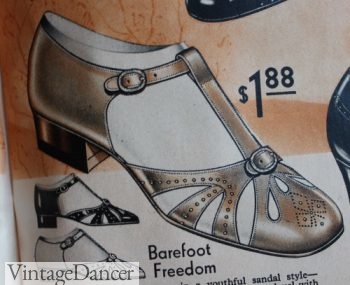
1930s T Strap sandals
For your casual 1930s flats, look for sandals, low heel Oxfords, saddle Oxfords, and canvas flats. For your evening looks, try a T-strap or classic Mary Jane in black patent, silver, or gold.
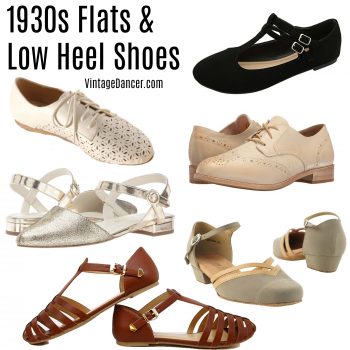
1930s style flats-casual to dressy sandals, strappy pumps and oxfords
1940s Flats
The 1940s were a turning point for low heel shoes. Women were working more, dressing more practically/casually, and needed footwear to match. Heels were still worn for dress up activities, but low heel slip-on shoes, wedges, and Oxfords were preferred for day to day life. With a stocking shortage during the war, women were used to wearing socks or nothing with their shoes even while wearing dresses. Saddle shoes, sneakers and canvas Mary Jane’s continued to be worn in the ’40s as well.
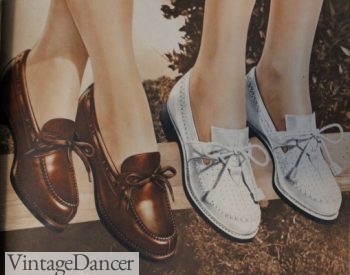
1940s loafers were worn as often as heels if not more
The ’40s also saw new casual shoe styles emerge. The slip-on shoe in the form of a loafer, moccasin, slingback, or slipper was the ideal ’40s shoe for practical women. The loafer with “penny slot” or tassel ties was worn by teens and women in dresses or casual clothing equally. Brown, white, or two-tone loafers were classic, while fun green, red, or blue made a splash in summer. The moccasin was a similar style to the loafer and is often called the same thing.
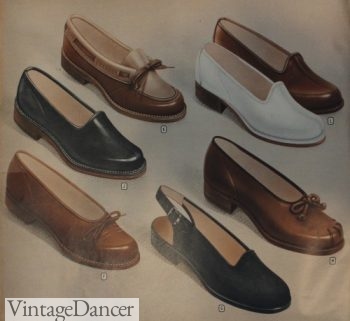
1940s Slip-on shoes
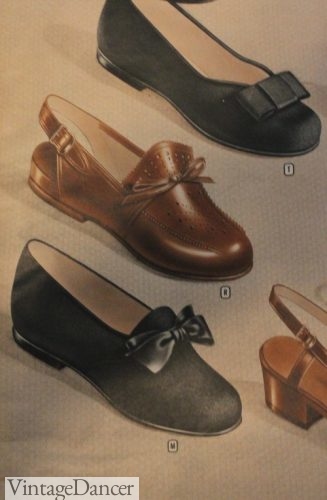
1940s bow flats
The slip-on slipper was the precursor to the ’50s ballet flat. They had no straps but usually a decorative bow on the toe. The difference between the two styles is the amount of skin showing. 1940s slip-ons covered most of the foot while the ’50s had thin sides and low toe coverage just like modern ballet flats have. The heel was very tiny too. A popular summer version was the slingback with a strap around the heel.
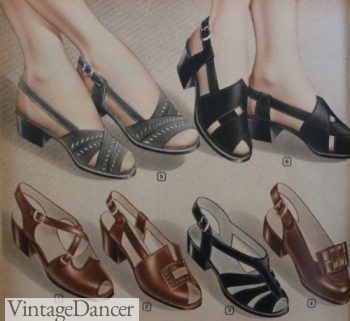
1940s sandals with low heels
The sandals with many straps or cutouts were in fashion in the summer. Sandals with high heels didn’t make sense on the beach, so lower heels were preferred. They usually had peep toes, too.
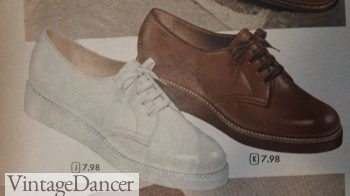
1940s wedge oxfords
Wedges were a new popular heel style, but they also were paired with Oxfords, loafers, and moccasins. The rise was very minimal since the sole was thick on many wedge shoes. They offered the illusion of a heel, but the stability of a flat.
For 1940s style flats today, I choose saddle shoes, loafers or wedges, or Oxfords for casual looks or with simple day dresses. For dressier occasions, a slip-on shoe with decorative toe clip or patent leather slingback looks really nice with most cocktail dresses.
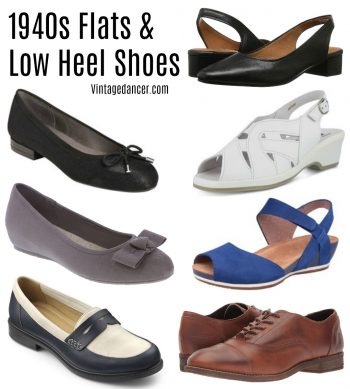
1940s style flats and low heel shoes for casual to dressy
1950s Flats
The practical flats of the late 1940s continued into the 1950s, but now with an explosion of options. The ’40s flat looked masculine, heavy, durable. The ’50s flat was more feminine, streamlined, and decorative. Women now preferred flats, changing only into heels when husbands were home, guests were visiting, or when they went out on the town. Slip-on flats were preferred over anything with a strap for most of the decade. Color choices were more diverse as well. Black flats went with everything and were the most common, but matching shoes to a dress or purse showed pride in appearance. Flats were affordable, too, so women could buy several pairs for each season.
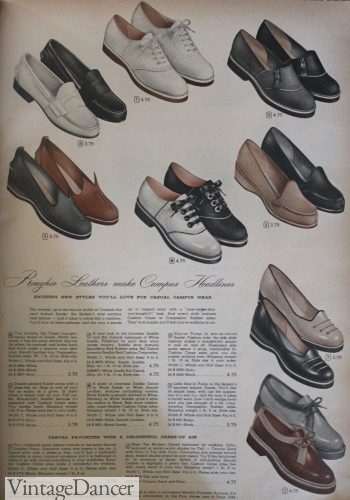
1950s casual flats, loafers, oxfords
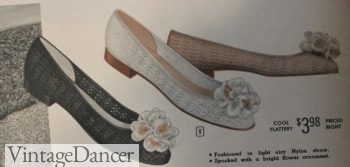
Summer flats with lace weave and flower cluster
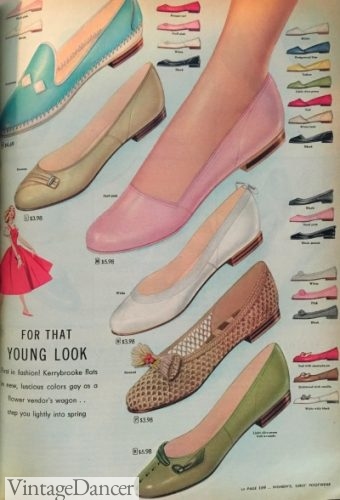
1950s junior flats- so many colors!
The late ’50s slimmed down the flat and elongated the toe. Pointy toe flats today are near identical to those of the 1950s and 1960s. So are flats with embroidery, ballet flats with small bows, and single straps with the strap close to the toe. It is easy to dress up 1950s with nearly any flat or low heel shoe you can find in stores now.
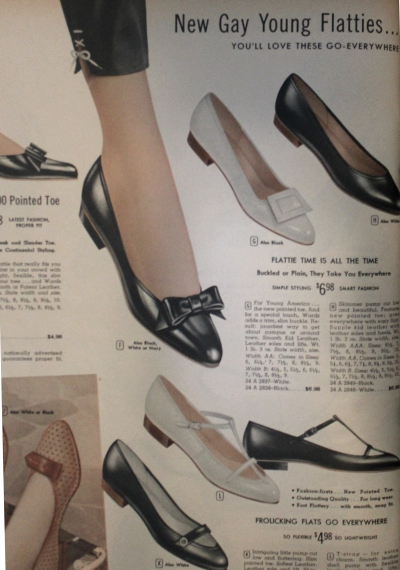
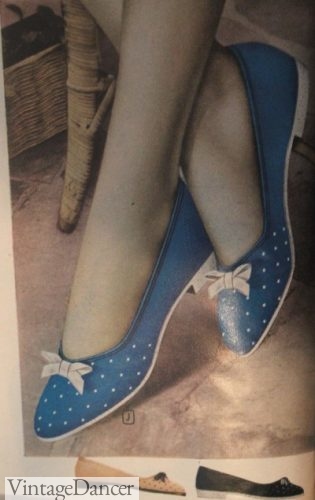
Polka dot flats
In the 1950s, the sneaker moved from being only a sport shoe to something for everyday fashion, especially with teens. White “Keds” type shoes we saw in the 1920s and 1930s were still being worn in the 1950s, this time in bold colors such as red, blue, yellow, and black. Instead of sports clothing, they were worn with dresses. Classic black and white saddle shoes were also still being worn in new color combinations and with a slimmer silhouette.
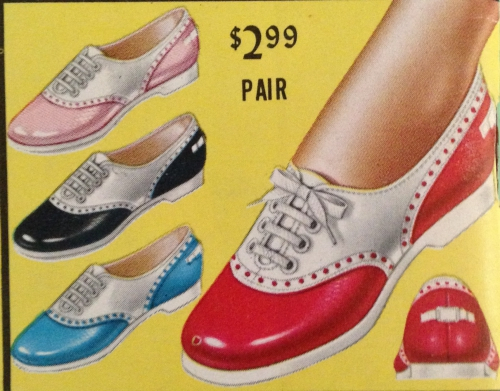
1950s saddle shoes
What about the 1960s? I was going to include them here, but by the ’60s, everything was flat, including most boots. Pointy toe flats in mod colors, loafers, moccasins, and sandals were worn with dresses and casual clothes equally. It was the era of flats. It is also the era of footwear today. Most flats available today are modeled after the 1960s styles. Dressing up ’60s is a piece of cake!
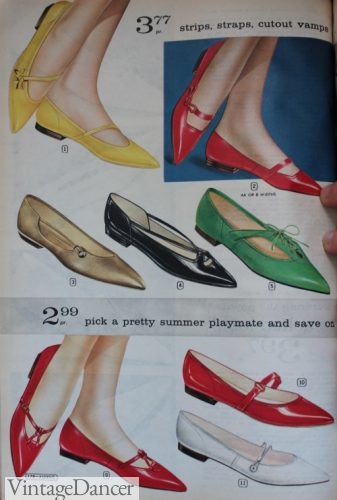
1960s flats in bright colors
Debbie Sessions has been teaching fashion history and helping people dress for vintage themed events since 2009. She has turned a hobby into VintageDancer.com with hundreds of well researched articles and hand picked links to vintage inspired clothing online. She aims to make dressing accurately (or not) an affordable option for all. Oh, and she dances too.
